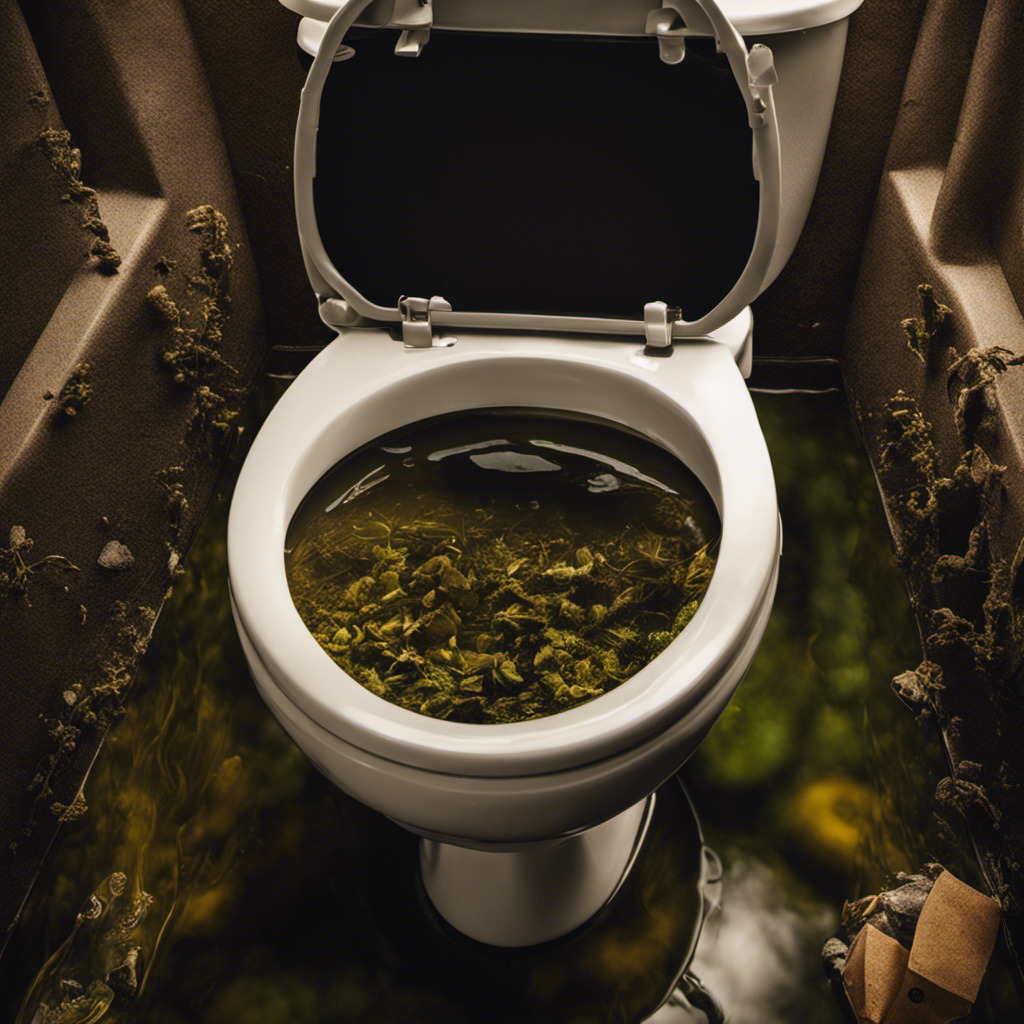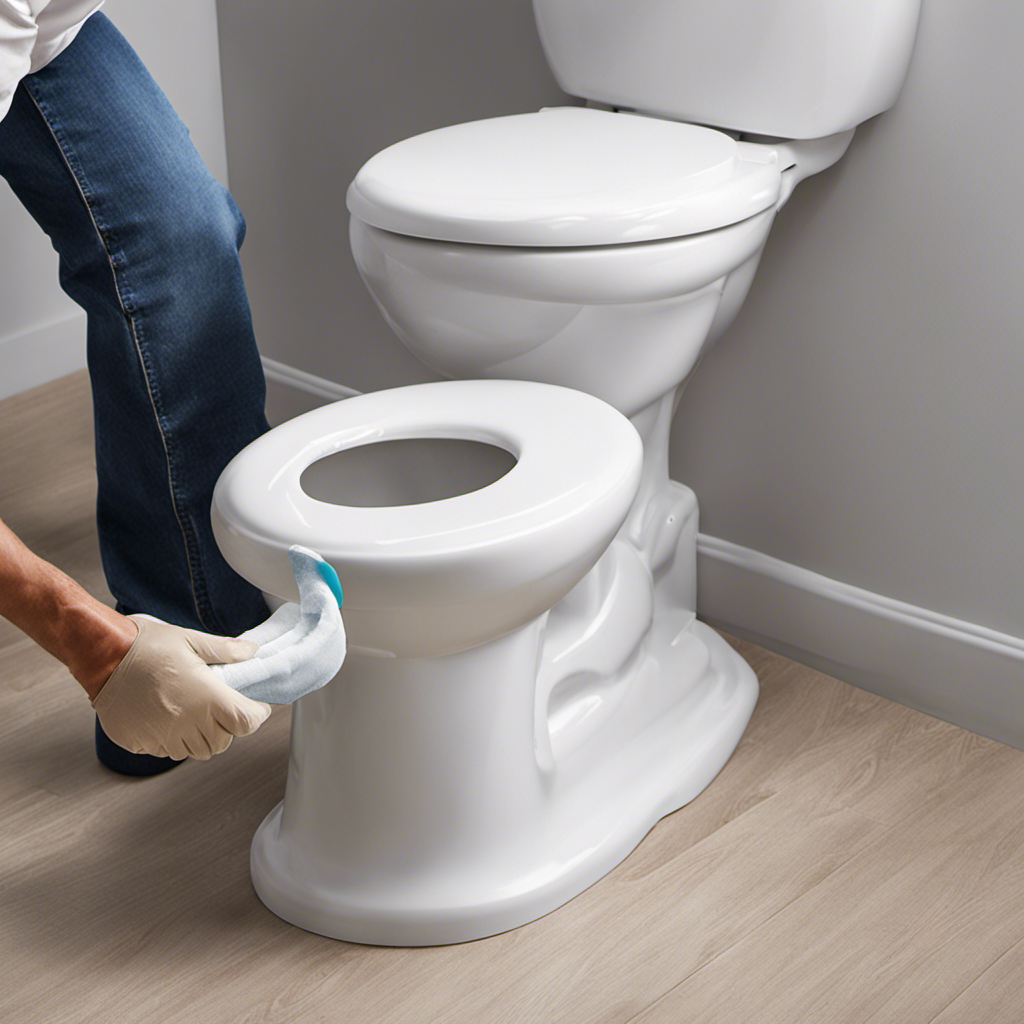Hey there, fellow bathroom aficionados!
Let’s face it, we’ve all experienced those less-than-satisfactory flushes that leave us feeling frustrated and, well, a little grossed out.
But fear not, because I’ve got the insider tips and tricks to help you make your toilet flush better than ever before. Say goodbye to weak flushes and hello to a truly powerful flush that will leave you feeling confident and refreshed.
So buckle up, my friends, because we’re about to dive into the wonderful world of toilet flushing optimization.
Let’s get flushing!
Key Takeaways
- Check and adjust the water level in the tank to ensure optimal flushing power.
- Regularly clean the flapper and flush valve to remove mineral deposits and debris.
- Use a plunger to dislodge minor clogs and improve flush power.
- Consider upgrading to a dual-flush system to conserve water and enhance flush efficiency.
Identifying Common Toilet Flush Problems
If you’re wondering why your toilet isn’t flushing properly, there are a few common issues you can look out for. Troubleshooting weak flushes can be a frustrating task, but understanding toilet bowl water flow is key to resolving the problem.
One possible cause of a weak flush is a clogged toilet drain. Debris, such as toilet paper or foreign objects, can restrict the flow of water and prevent a strong flush.
Another issue could be a malfunctioning flapper valve. This valve controls the release of water from the tank to the bowl during a flush. If it is not opening fully or closing properly, it can result in a weak flush.
Additionally, a low water level in the tank can also lead to reduced flushing power.
Checking and Adjusting the Water Level
You can check and adjust the water level in your toilet for optimal flushing. Maintaining the correct water level is crucial for efficient flushing and preventing any potential issues. Here are some important steps to follow:
-
Measure water pressure: Use a pressure gauge to check the water pressure in your toilet. The ideal pressure range is typically between 20 and 50 pounds per square inch (psi).
-
Adjust the toilet tank float: Locate the toilet tank float, which is usually a ball or a cup attached to a rod. Adjust the float to ensure it is set at the correct level, which is typically around 1 inch below the overflow tube.
-
Check for leaks: Inspect the toilet tank and connections for any signs of leaks. Fixing leaks promptly can help maintain the proper water level.
-
Test the flush: After adjusting the water level, flush the toilet and observe the flushing performance. If necessary, make further adjustments to achieve optimal flushing.
Cleaning the Flapper and Flush Valve
Cleaning the flapper and flush valve is an important part of maintaining a properly functioning toilet. As someone who has dealt with various toilet issues, I can assure you that keeping these components clean is essential for optimal performance.
Over time, mineral deposits, debris, and even mold can build up on the flapper and flush valve, causing them to become less effective. To clean them, start by turning off the water supply to the toilet and flushing to empty the tank. Then, remove the flapper and flush valve and scrub them with a brush and mild detergent. Rinse them thoroughly before reinstalling.
If you notice any damage or wear, it may be time to consider replacing the toilet handle as well. Regularly cleaning and maintaining these components will ensure that your toilet flushes better, preventing clogs and other issues.
Improving Flush Power With a Plunger
Using a plunger is an effective way to increase the power of your toilet flush. I have had many years of experience dealing with clogged toilets and have found that using a plunger is often the easiest and quickest solution. Here are some reasons why a plunger can be a game-changer for improving flush power:
- Creates pressure and suction to dislodge stubborn clogs
- Works well for minor blockages caused by toilet paper or waste
- Can be used in conjunction with a toilet auger for more stubborn clogs
- Affordable and readily available at most hardware stores
When using a plunger, it’s important to create a good seal around the drain hole and apply firm pressure with an up-and-down motion. If the clog persists, it may be necessary to use a toilet auger to reach deeper into the drain and break up the obstruction.
Overall, a plunger is a valuable tool in your arsenal for unclogging drains and improving your toilet’s flush power.
Upgrading Your Toilet’s Flushing Mechanism
When upgrading your toilet’s flushing mechanism, it’s important to consider the water-saving benefits of a dual-flush system. These eco-friendly toilet upgrades not only help conserve water, but also improve toilet flush efficiency. With a dual-flush system, you have the option to choose between a full flush and a half flush, depending on the waste you need to dispose of. This allows for more efficient water usage, as you can use less water for liquid waste and more water for solid waste.
To give you a better idea of the benefits of a dual-flush system, here’s a comparison table:
| Flush Type | Water Usage (gallons) |
|---|---|
| Full Flush | 1.6 |
| Half Flush | 0.8 |
As you can see, a dual-flush system can help reduce water consumption by up to 50% compared to traditional single-flush toilets. This not only helps the environment but also lowers your water bills. So, when considering upgrades for your toilet, be sure to prioritize water-saving options like a dual-flush system.
Frequently Asked Questions
How Do I Fix a Leaking Toilet?
To fix a leaking toilet, start by turning off the water supply to the toilet tank. Next, carefully remove the lid and inspect the toilet flapper for any signs of wear or damage. Replace if necessary.
What Can I Do if My Toilet Bowl Is Not Filling up With Enough Water?
When the toilet bowl doesn’t fill up with enough water, it can be frustrating. But don’t worry, there are ways to increase the water flow and troubleshoot low water pressure. Let me share some expert tips.
Is It Normal for My Toilet to Make a Gurgling Sound After Flushing?
Yes, it is normal for a toilet to make a gurgling sound after flushing. It could indicate a problem with the plumbing or a clog. Troubleshooting toilet gurgling involves checking the vent stack and performing toilet bowl maintenance.
How Can I Prevent My Toilet From Clogging Frequently?
To prevent frequent clogs, I’ve found that maintaining proper water pressure and minimizing toilet bowl stains is crucial. By using a plunger and regular cleaning, I’ve improved my toilet’s flushing efficiency.
Why Does My Toilet Sometimes Flush Weakly and Other Times Flush Strongly?
Sometimes my toilet flushes weakly because of issues with the toilet flush mechanism. Troubleshooting weak toilet flush involves checking water level, clogs, and adjusting the flapper or fill valve.
Conclusion
After going through the steps to improve my toilet’s flush, I can confidently say that my toilet now flushes better than ever.
By identifying common flush problems, adjusting the water level, and cleaning the flapper and flush valve, I was able to optimize the flushing mechanism.
However, if you’re looking for an even more powerful flush, consider upgrading your toilet’s flushing mechanism.
With these techniques, I have transformed my toilet into a high-performing, efficient machine.
Now, I can rest assured that my bathroom experiences will be nothing short of exceptional.










